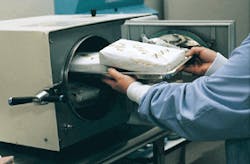Technique ensures sterility where clean meets contaminated at sterilizers door
Diane Blanchette, RDH
Infection control procedures have evolved significantly since I graduated from dental hygiene school in 1978. Alcohol wipes, headrest covers, instrument scrubbing, and sterilization were routine. Now, "spray-wipe-spray," phenolics, hepatitis B vaccines, and sterilization monitoring are a part of everyday terminology for dental hygiene clinicians.
While teaching infection control procedures to preclinical and clinical dental hygiene students, I became aware of a commonly mishandled area in dental offices. There is one place in the office where the "most contaminated" meets "sterile;" that is at the door of the sterilizing unit (i.e. autoclave, chemical, etc.). My observations are that clinicians frequently load the sterilizing unit with gloves because the wrapped instruments or bags are contaminated. After the sterilizing cycle is complete, the clinician then opens the door to retrieve sterile instruments with bare hands. Cross contamination has occurred unless the door to the unit was completely disinfected each time during the cycle or an alternative method is used to load it.
Many methods can be implemented, as long as the outside of the sterilizer is treated as always "contaminated" or always clean (preferred). I offer a method to readers that I teach to the dental hygiene students at the University of Maine at Augusta. The two most important aspects of this procedure are that the outside of the sterilizer is treated as "clean" and that everyone in the office handles the sterilizer the same way. With this method, the clinician should use clean hands whenever handling the outside of the sterilizer and filling the reservoir with water or solution.
My suggested method includes leaving your dominant hand bare and wearing a utility glove on your nondominant hand.
The steps include:
- Hold the cassette/tray with your bare hand.
- Place unsterile bags/instruments on the tray with your gloved hand. (One student suggested to then put the gloved hand behind your back to avoid further contact.)
- With your bare hand, place the tray into the sterilizer, fill the chamber with fluid, set controls, close the door, and set the timer.
- Wash hands thoroughly after removing the utility glove.
- When the cycle is completed - with clean and bare hands - vent, dry, cool, and remove the sterile bags or instruments.
I find it helpful to have a left-handed (or nondominant hand) nitrile glove (that is large enough to slide into) hanging near the contaminated instrument bags that are waiting to be sterilized. I suggest sterilizing the nitrile glove with the last load of the day.
I believe that once you have done this a few times it will become second nature as it has for me.
Diane Blanchette, RDH, MeD, is the assistant professor of dental health at the University College of Bangor and the University of Maine at Augusta.
Place tray of contaminated instruments into the sterilizer without contaminating the outside of the door.
Take sterile instruments out with clean, bare hands.


